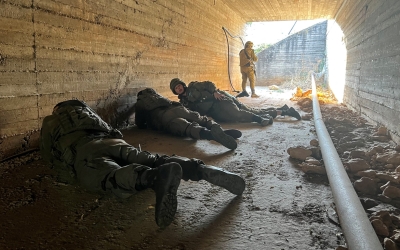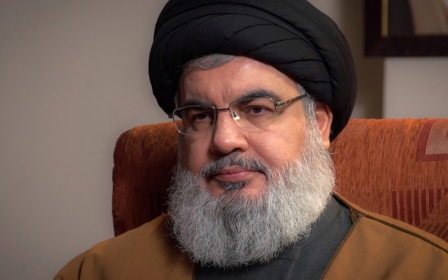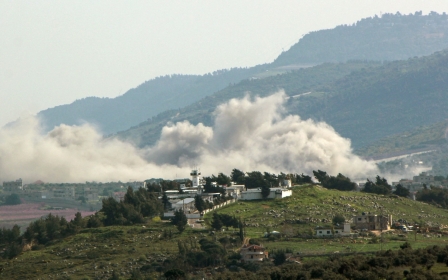Hezbollah sends 'message of deterrence' with attack on Israeli Iron Dome battery

Hezbollah’s attack on an Israeli Iron Dome battery earlier this week was the clearest message of deterrence since the start of the hostilities on the Israeli-Lebanese boundary last year, according to a military analyst.
On Wednesday, the Lebanese group struck the Iron Dome launcher in Ramot Naftali, around 3km from Lebanon’s border, and released footage that showed a guided missile flying into the air defence system.
The video of the attack, published on Thursday, does not show whether the Iron Dome launcher was damaged or destroyed.
The Israeli army has said it was not aware of any damage to its Iron Dome launchers. However, the footage has been geolocated and experts have said it looked genuine.
Military analyst Mustafa Asaad told Middle East Eye that Hezbollah has gradually revealed a small sample of the weapons in its possession, conveying to Israel that “they are willing to play the end game when the need arises”.
New MEE newsletter: Jerusalem Dispatch
Sign up to get the latest insights and analysis on Israel-Palestine, alongside Turkey Unpacked and other MEE newsletters
An adapted Israeli missile
During the current conflict, ongoing since 7 October, Hezbollah has deployed three types of new, precision-guided missiles, known as Almas, or Diamond.
The Almas missile family was reverse-engineered based on the Israeli Spike missile captured during the Israel-Lebanon 2006 war and developed by Iran, according to Asaad.
The Almas missile can either lock onto its targets from the outset or be guided remotely by an operator with high precision.
According to Israeli research centre Alma, this weapon poses a serious challenge to most stationary and mobile targets in border areas.
Asaad said Hezbollah likely targeted the Iron Dome unit with the Almas 3, which has a better range and optics, and a larger destructive warhead than the 1 and 2 versions.
“Almas 3 is beyond any doubt a serious weapon that the Israelis cannot counter. It is guided by an electro-optical guidance system connected to a fibre optic relay cable, making it impossible to jam or counter,” the analyst said.
Israel has used the Iron Dome to intercept rockets fired by Hamas and Hezbollah since it was introduced in 2011, largely in response to the 2006 war.
It shoots down short-range rockets by using interceptor Tamir missiles and radar technology.
The system has become an integral part of Israel's defence arsenal and is expensive to operate against incoming threats that are significantly cheaper.
Each Iron Dome battery, which consists of three to four launchers, can cost up to $100 million.
Israel claims the interception rate for the Iron Dome is around 90 percent, though some experts have put that figure closer to 80 percent.
'Deterrence message'
Hezbollah’s use of more advanced weaponry, including the Almas missiles, drones capable of firing missiles, and explosive drones, has raised alarms within the Israeli military.
Asaad said that while Israel’s advanced defence technology allows it to counter Iranian long-range missiles due to the effectiveness of its wide-ranged radar detection, Hezbollah’s short-range attacks are much more difficult to detect fast enough or counter effectively.
'Hezbollah stands with advanced technology like drones and guided missiles that are immune to Israeli tech'
- Mustafa Asaad, military analyst
“Hezbollah and Iran are sending the clearest deterrence message to Israel. This places Israel’s extremist government under a threat that they cannot truly counter,” he said.
Hezbollah has recently demonstrated the different types of weapons it carries in its arsenal, estimated to hold 130,000 rockets and missiles.
Over the past two weeks, it shot down a large surveillance drone, a Hermes 900, with a surface-to-air missile and launched for the first time an explosive squadron of drones towards a military headquarters in Galilee.
On Wednesday, Hezbollah claimed a "kamikaze" drone attack on a military position in the town of Hurfeish, 3km from the border, that killed a soldier and wounded 12 others.
The attack followed a visit by Prime Minister Benjamin Netanyahu to Israel's northern region, during which he warned that Israel was prepared for very strong action.
In late May, the group deployed a new type of weapon, an armed attack drone equipped with two S-5 rockets, on a military position in the northern Israeli town of Metula, marking its first-ever air strike on Israel.
“In the past, any weapon could have been countered, but today Hezbollah stands with advanced technology like drones and guided missiles that are immune to Israeli tech,” Asaad said.
The analyst believes this has pushed Israel to ramp up the rhetoric of war against Lebanon in recent days.
“Israel suddenly finds itself in an open conflict that cannot be contained by an air force or intensive air raids,” he said.
“The entire northern front poses a critical threat to all bases adjacent to the frontier and suppression is no longer possible.”
Middle East Eye delivers independent and unrivalled coverage and analysis of the Middle East, North Africa and beyond. To learn more about republishing this content and the associated fees, please fill out this form. More about MEE can be found here.





